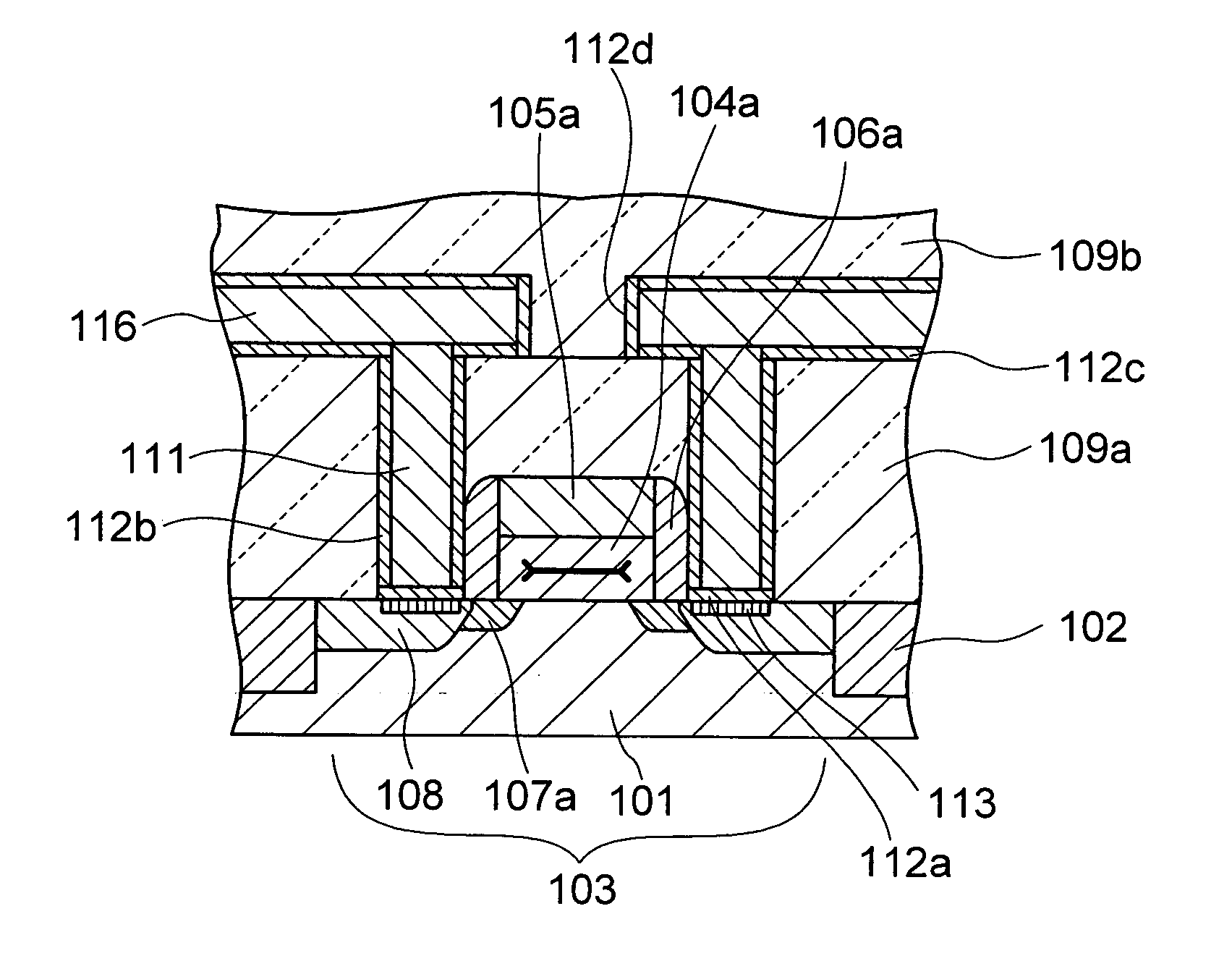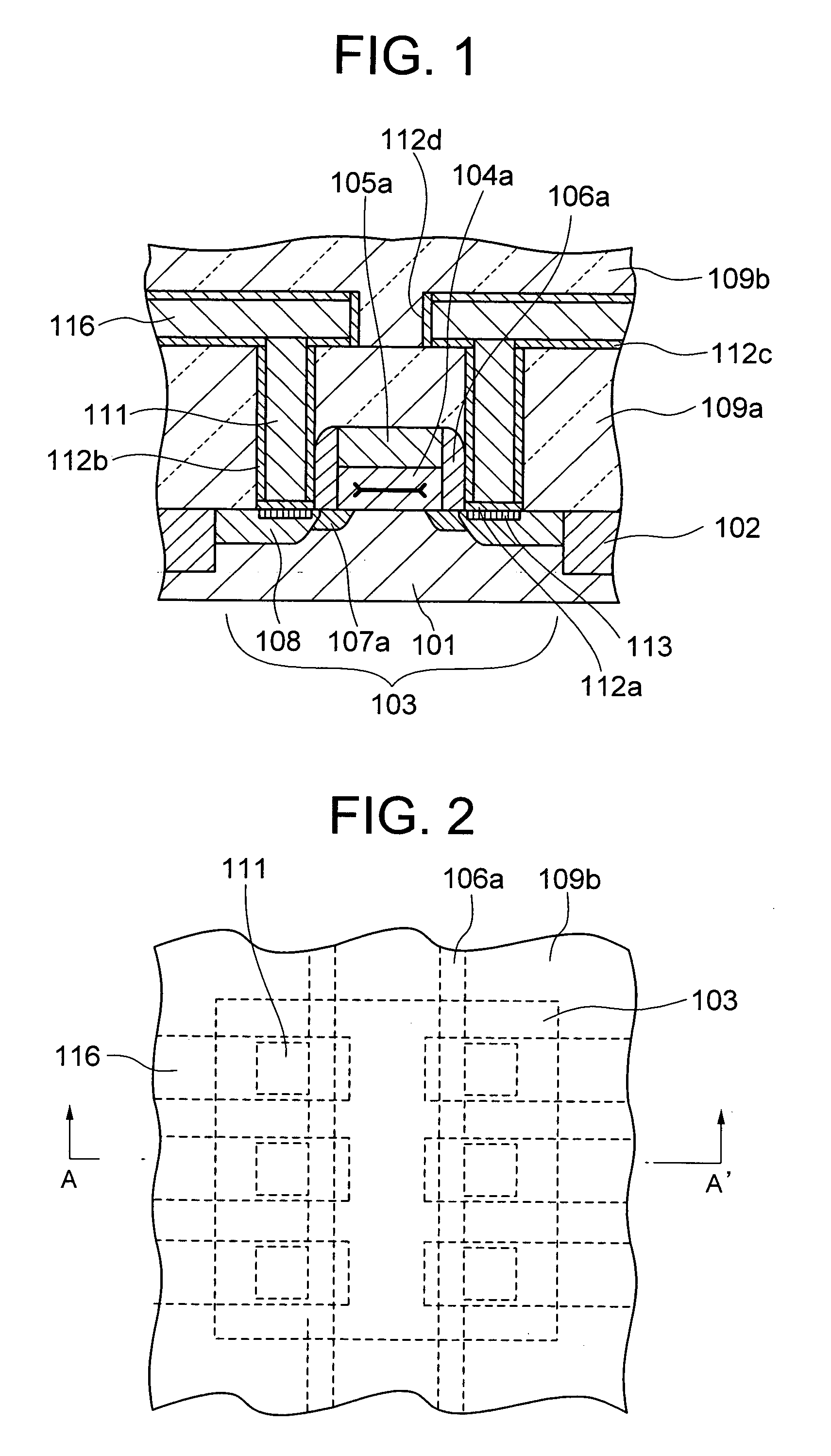Semiconductor device
a technology of semiconductor devices and dielectric devices, which is applied in the direction of semiconductor devices, semiconductor/solid-state device details, electrical apparatus, etc., can solve the problems of reducing the mobility of the inversion layer, increasing the fixed electrical charge in the layer, and difficulty in maintaining the dielectric properties of high-k materials. , to achieve the effect of suppressing the increase of fn leakage current, high reliability, and high speed operation
- Summary
- Abstract
- Description
- Claims
- Application Information
AI Technical Summary
Benefits of technology
Problems solved by technology
Method used
Image
Examples
embodiment 1
[0050] A sectional structure of a main portion of a semiconductor device according to a first embodiment of the present invention is shown in FIG. 1, which is a sectional view taken along A-A′ in an example of a layout in a plan view shown in FIG. 2. The semiconductor device of the embodiment includes, as shown in FIG. 1, a device separation layer 102 of silicon oxide layer formed in the surface of a P-type silicon substrate 101 and a device formation area 103. The embodiment shows the semiconductor device having an electric field effect type transistor by way of example. An N-channel MOS (NMOS) transistor is formed in the device formation area 103.
[0051] The MOS transistor includes a gate insulating layer 104a and a gate electrode 105a. A side wall 106a of silicon oxide, for example, is formed on the side of the gate electrode 105a. The gate insulating layer 104a is made of SiON. The gate electrode 105a is, for example, polycrystalline silicon layer, metal thin film layer, metal s...
embodiment 2
[0065] A second embodiment of the present invention is now described with reference to FIGS. 6A to 6D and FIGS. 7A to 7C. In order to make the gate insulating layer to the compressed strain state, the gate electrode is made to the tensile strain state, for example. The gate electrode is made to the tensile strain state, so that the gate insulating layer disposed under the gate electrode is formed to be made to the compressed strain state as a result of its reaction.
[0066]FIGS. 6A to 6D and FIGS. 7A to 7C illustrate the manufacturing method of the semiconductor device including the gate electrode in the tensile strain state and the SiON gate insulating layer in the compressed strain state.
[0067] First, groove having the depth of 200 to 300 nm are formed in the surface of a P-type silicon substrate 101 and silicon oxide layer is embedded therein to form device separation layer 102 of shallow groove type (FIG. 6A).
[0068] Next, the surface of the silicon substrate 101 is thermally ox...
embodiment 3
[0085] In the embodiment 3, after formation of the SiON layer by the thermal oxidization of the surface of the silicon substrate 101 in the embodiment 2, an amorphous silicon layer 115 containing impurity phosphorus (P) is formed by means of the CVD method or the like.
[0086] Thereafter, the temperature of the semiconductor substrate is raised to 600° C. or more so that the amorphous silicon layer 115 is crystallized to be the polycrystalline silicon layer 105. Since the crystallization of the amorphous silicon contracts its volume, the polycrystalline silicon layer 105 formed by the crystallization becomes the tensile strain state. As a result of the reaction of the tensile strain, the SiON gate insulating layer 104 under the polycrystalline silicon layer 105 becomes the compressed strain state (FIG. 6D). The crystallization of the amorphous silicon layer 115 can be made by controlling the temperature of the semiconductor substrate, although it may be made by irradiation of laser. ...
PUM
 Login to View More
Login to View More Abstract
Description
Claims
Application Information
 Login to View More
Login to View More - R&D
- Intellectual Property
- Life Sciences
- Materials
- Tech Scout
- Unparalleled Data Quality
- Higher Quality Content
- 60% Fewer Hallucinations
Browse by: Latest US Patents, China's latest patents, Technical Efficacy Thesaurus, Application Domain, Technology Topic, Popular Technical Reports.
© 2025 PatSnap. All rights reserved.Legal|Privacy policy|Modern Slavery Act Transparency Statement|Sitemap|About US| Contact US: help@patsnap.com



